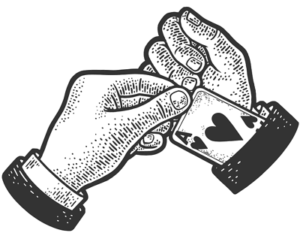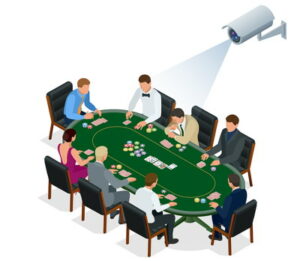 Cheating and casino gaming are two things that have gone hand-in-hand in history. It’s an unfortunate outcome, but there will always be someone looking to cheat the games. If that’s not the case, then there will also be casinos looking to cheat their players.
Cheating and casino gaming are two things that have gone hand-in-hand in history. It’s an unfortunate outcome, but there will always be someone looking to cheat the games. If that’s not the case, then there will also be casinos looking to cheat their players.
Various cases have come to light where both of those outcomes have occurred. Players get cheated out of their money or a casino gets cheated out of its money. Of course, it’s also the case that cheaters can get caught in the act. That leads to an unsuccessful attempt at gaining money by cheating. So, we want to look a bit more at these cheating attempts.
Here, we’ll take a look at some instances of casino cheating. That relates both to casinos cheating players and vice versa. We want to know about the methods that have failed in a miserable way. Yet we also want to look at those cheating methods that have succeeded for players or casinos. Join us to find out about various ways that cheats have operated within casino venues.
Casinos Cheating People
 Most people would likely imagine that it is the players who are cheating casinos. Of course, there is more likelihood of this being the case. Yet casinos have also cheated their players in history. This has all occurred as a way for the casinos to ensure they make profit. It’s not difficult to find stories of this happening. From way back in the 1800s up to modern day casinos, cheats remain in action.
Most people would likely imagine that it is the players who are cheating casinos. Of course, there is more likelihood of this being the case. Yet casinos have also cheated their players in history. This has all occurred as a way for the casinos to ensure they make profit. It’s not difficult to find stories of this happening. From way back in the 1800s up to modern day casinos, cheats remain in action.
A game of Faro existed back in the 1800s and continued in play through to the 1980s. It originated in France as a card game, descending from Basset. Winning or losing occurs when cards turned up by the banker match those already exposed. It was as popular as poker gaming at one point, thanks to its ease of understanding for players. Yet it became a focus for crooked casinos to put into action, leading to it falling out of favour.
Faro has a low house edge, which is why casinos started to dislike operating it. They incorporated rigged dealer boxes into gameplay. Those boxes are in place to ensure that cards go through a proper shuffle and are random between rounds.
With the rigged boxes, croupiers could see inside them. Then, it was down to them to use sleight of hand. In doing so, they made sure that those cards which would have ensured a payout never made it to the table. Players cottoned on to what the casinos were doing in the end, and this led to the decline in Faro’s popularity. After this, it disappeared from many casinos.
It’s not only on casino games that venues cheat people, either. Such was the case back in 2002 when The Venetian in Las Vegas rigged a prize draw. The casino wanted to compensate a high-stakes gambler who had suffered heavy losses. To do this, it chose to rig a contest, which awarded the losing gambler a Mercedes-Benz.
To do this, an executive hid a ticket with the player’s name on it up their sleeve. Then, they proceeded to choose a ticket “at random” from a jar. This turned out to be the losing gambler’s name from up the executive’s sleeve. At the same time, two other executives of The Venetian knew about the scam.
 An investigation by the Nevada Gaming Control Board occurred afterwards. The body discovered that the casino had also preselected winners for other contests. Those awarded $10,000 and $20,000-worth of free play in the casino. As a result, The Venetian received a $1 million fine. In total, $663,000 of that money was the penalty for cheating in various draws. The remaining $337,000 was for investigation costs from the Board.
An investigation by the Nevada Gaming Control Board occurred afterwards. The body discovered that the casino had also preselected winners for other contests. Those awarded $10,000 and $20,000-worth of free play in the casino. As a result, The Venetian received a $1 million fine. In total, $663,000 of that money was the penalty for cheating in various draws. The remaining $337,000 was for investigation costs from the Board.
Rigged games are often the route that crooked casinos take to cheat players, though. This even happens at online casinos from time to time. Such was the case back in 2011 when a player complained over software developer Amigotechs. In a post on an online forum, the player detailed their gameplay.
This stated that they had logged 922 hands on a 50-line video poker game. Throughout it all, they had never experienced a winning hand. Amigotechs admitted that the game had a software fault after mounting pressure. Yet it didn’t clean up its act, and in 2015 the same sort of outcome occurred. Amigotechs is very rarely found at online casinos today because of this.
That’s not all, because investigations in some Chicago casinos found rigged roulette wheels. During the 1920s Prohibition Era in the USA, underground casinos were common. Notorious gangster Al Capone was the owner of these establishments. He made his fortune through various immoral practices. One of those ways was with rigged roulette wheels. This was not discovered until almost a century later, though!
Restoration experts investigated the wheels closer to find their rigging systems. This was as follows:
- A hollow leg below the table existed where two battery packs were installed.
- Mobsters would pack the leg with newspapers to keep the batteries in position.
- Those batteries served as an important part of an electrical circuit to help the dealer with rigging the wheels.
- A concealed button pressed by the dealer would cause a pin to rise in the wheel’s field of play.
- The pin would hit the ball, stop its spinning momentum and cause it to drop in a certain section of the wheel. That section would usually be the one that caused the most players to lose.
Players Cheating Casinos
 It may seem like casinos are the responsible parties for cheating judging by the insights above. Yet players can be just as bad, if not worse when it comes to cheating. Inside casinos, security has increased to try and catch any cheats in action. This means that cameras are watching every move that you make inside. It hasn’t stopped some people from engaging in cheating, though.
It may seem like casinos are the responsible parties for cheating judging by the insights above. Yet players can be just as bad, if not worse when it comes to cheating. Inside casinos, security has increased to try and catch any cheats in action. This means that cameras are watching every move that you make inside. It hasn’t stopped some people from engaging in cheating, though.
Collusion with a dealer is one of the routes taken by some gamblers. This sees them work in unison with one or more dealers at the tables. Such was the case in 2015 when a report came up about a man befriending three dealers. They worked at the Resorts World Sentosa Casino in Singapore.
It was 65-year-old Chua Lai Huat who formed a relationship with the three croupiers. He managed to convince them to give him an unfair advantage at the casino tables. Chua would bend the corners of his ace and king cards when dealt. Or he would mark them with an improvised rheumatism plaster. Thus, he could identify them when he needed.
The croupiers would also flash the final card in the deck to him. That gave Chua another advantage in making informed decisions. The scheme continued for two months, and he won a total of $12,915. A total of $1,200 of that went to the three dealers involved, too. Upon his cheating discovery, Chua pled guilty to 10 counts of this in court. He received a year in jail for his acts, while two of the colluding dealers were also jailed.
It may be the case that card switching takes place as well. This also goes by the name of hand mucking in the industry. It’s a cheating scheme that has been around for many years. Rather than using simple sleight-of-hand routes, hidden “holdout” devices are in operation today. That device hides a card up a player’s sleeve, and it deposits it on the table later when needed. It also removes and hides the cards used afterwards. This scam went into operation at the Foxwoods Casino Resort in Connecticut in 2010.
Two South Korean nationals managed to cheat several hundred thousand dollars through it. Young Su Gy, 60, and Wookyung Kim, 34, utilised the holdout device to enact their cheating. This saw them switch cards in the middle of Macau-style midi-baccarat games. While Gy was the one putting the device into action, Kim acted as a blocker. In doing so, she distracted the casino employees, ensuring they didn’t see Gy’s trick.
The pair didn’t get away with their scheme for long. Authorities caught them in the act. In the U.S. District Court in Hartford, Gy and Kim received sentences of over a year of jailtime. They also got three years of supervised release and had to pay restitution of $870,505.

Slot machines have also been on the receiving end of scams in casinos. Cheating methods have adapted as the machines have themselves. In older slot machines, cheaters were able to attach pieces of string to a coin. A paper clip on the end of this prevented the coin falling into the hopper. A player could then play limitless games. As the security systems improved, so too did the scams. The newest way of scamming slots involves a small computer device. This tricks the cash note validator.
Often times, the device comes in the form of a $1 bill, and it has two prongs on it. Players insert these into the bill validator. Once they hit the contact point below the validator, this serves the player. The slot machine will read any bill inserted into it as a $100 bill. Casinos did catch on to this routine and this led to the scam fading out for the most part. Most slot machines are also retrofitted so that the devices do not work anymore.
Some people also determine card counting as cheating. Yet this is something that several people have enacted over the years. It takes a lot of concentration and good memory to utilise in a proper way. Plus, it all depends on how often the cards go through a shuffle during gameplay. Instead, gamblers who count cards are “advantage players”, rather than scammers.
The same is true of hole card reading. This happens in games like Texas Hold’em and three card poker. It sees a player try to spot the dealer’s hole card – the face-down one. Through doing so, the player has a better advantage of how to continue with gameplay. This only crosses the line into cheating if a player utilises a device or mirror to see the card.
If you play craps, then you may also have seen a form of cheating going on. This sees a player slide the dice down the table instead of rolling them in a proper way. Of course, a slide of the dice doesn’t see the numbers on them change. In most instances, cheaters will try to only control one of the dice. The bouncing one will thus get the attention of all, while the sliding one passes by their eyes. Sometimes, a sleight-of-hand spin of the die while it slides occurs. This adds to the deception, too.

In September of 2011, this sort of tactic happened in Wynn Las Vegas casino. Two Argentinians visited the venue and won $700,000 playing craps. The casino accused them of cheating via dice sliding to win that amount. It led to the arrests of Leonardo Fernandez and Veronica Dabul. According to reports, they had the help of several unidentified customers in their scam. Those players placed wagers and distracted the craps dealers. That gave Fernandez and Dabul the opportunity to enact the dice slide. Wynn Las Vegas sued the pair for the $700,000 winnings.
One final scam that has occurred in casinos is past posting. This happens on games of roulette, and it is one of the oldest cheats in casino history. It plagues the industry even today, according to experts. Cheaters will place their chips on the winning roulette number after the ball falls into a slot. Often, it involves more than one player. The first distracts the roulette croupier, while the second pushes the chips to the winning number. It is common for the conspirator’s different-coloured chips to move, too. If the second player gets caught, his chips get removed. Yet the first player’s chips remain on the winning number after the fact.
